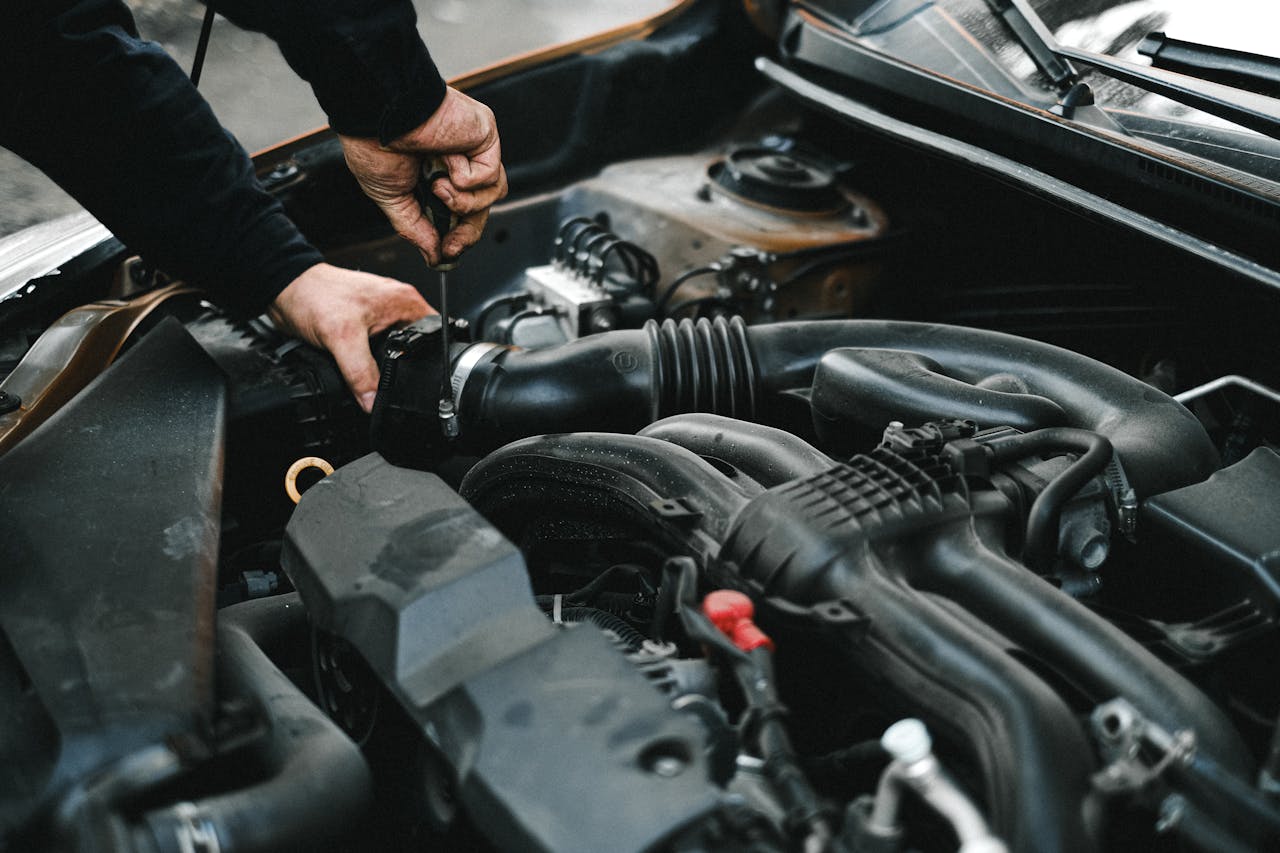The two most common causes of broken radiator fans in high-mileage cars are fan motor wear and bad electrical connections. Broken or frayed wiring and stuck fan relays can be factors in these problems.
This is an easy way to have fan blades crack over time due to age or impact with debris that prevents them from spinning correctly. Heat and dirt accumulate over the years, weakening the motor and producing brittle plastic.
An improper ground signal sent to the fan controller can prevent the fan from switching on at all. You may first notice unusual sounds or the temperature needle rising.
Understanding what breaks the most allows you to identify problems early before you’re left holding a boiling over engine. I’ll break down each cause, how to spot them, and what you can do to keep your car running cool.
Key Takeaways
- So I’d want to monitor my radiator fan performance really closely in high-mileage cars. As everything ages and wears, breakdowns and premature overheating become more likely.
- By routinely diagnosing electrical problems, checking for physical damage, and inspecting the motor for wear, I’m able to avoid the leading causes of fan failure.
- I should listen for unusual noises and watch for dashboard warning lights, as these often signal early fan problems that I can address before serious damage occurs.
- To prevent my fan from breaking, I can make sure that my entire cooling system stays clear and clean. Topping up your coolant levels is just as important as regularly checking them.
- When something doesn’t go according to plan, I systematically break down the troubleshooting process step-by-step. I check wiring, relays & sensors and when in doubt I order a professional diagnostics.
- I still replace broken radiator fans with OEM quality parts. By choosing OEM replacement with an aftermarket option, I guarantee the reliability of a reliable part while avoiding future overheating.
Spotting a Failing Radiator Fan
A failing radiator fan could spell disaster for your vehicle. Being mindful of this problem goes a long way in maintaining your vehicle well into the high mileage years. The radiator fan keeps the engine cool. If it fails, the engine can overheat quickly.
When you spot the warning signs before it’s too late, you prevent severe damage and expensive repair bills. Pay attention to your fan’s performance and monitor your coolant levels. Watch for any abnormal noises to spot problems before they develop into larger failures.
Engine Overheating Warning Signs
A dangerously hot engine is one of the most obvious indications that something is brewing under the hood. Keep an eye out for the temperature gauge climbing or steam coming from under the hood. Here are these indicators to look out for that may suggest a failing radiator fan.
Many drivers will see radiator coolant dripping beneath the vehicle or hear a hissing sound coming from the radiator. Visible signs such as rust on the radiator or an immediate drop in coolant levels are additional indicators of a failing radiator fan. When you start noticing these, taking quick action can save you from a blown head gasket or even warped engine components.
Fan Not Spinning When Expected
If the fan refuses to spin as the engine heats up, airflow decreases and heat starts to accumulate. The first step in diagnosing a radiator fan failure is to double check the fuse and wiring. Take your voltmeter and measure the voltage on one terminal.
If you measure 12V on one pin and 0V on the other, that means a fuse has blown. If you don’t own a voltmeter, supplying DC power directly to the fan is another way to test whether or not it’s functional. Occasionally, bad wiring or a defective relay is at fault.
Fan Running Continuously
A fan that won’t turn off could mean the ECU is getting the wrong signal from a coolant temperature sensor. This non-stop operation puts a heavy toll on the battery and reduces fuel efficiency.
In addition to starving the engine of air, this can prematurely wear the fan motor out. Inspecting the sensor and wiring is a good place to start to locate the main issue.
Unusual Noises from Fan Area
If your fan makes squeaking, grinding, or rattling noises, then you likely have worn bearings or an object caught in the blades. Pieces of debris or crumbled plastic worsen these sounds.
Identifying and repairing the issue as soon as possible prevents the fan from having a total failure.
Reduced Air Conditioning Output
A failing fan results in reduced airflow over the AC condenser. It’s getting hotter and you notice the air blowing out of your AC vents isn’t as cold as it used to be.
Either this occurs when the fan motor is underpowered, or your control unit is malfunctioning. When your AC isn’t blowing cold air the way it used to, the radiator fan is one of the first places to look.
Dashboard Warning Lights Illuminated
Check engine or coolant temperature warning lights may be indicative of a cooling system or fan issue. More often than not, these lights are accompanied by error codes that a scan tool can easily locate.
Accidentally driving with a failing radiator fan can lead to more costly repairs, so it’s best to take your car to an expert for a quick inspection.
Diagnosing the Root Cause
Diagnosing a failed radiator fan on a beater car with knobby tires and rusty jack points is a deep dive. Here’s an inside, step-by-step look at each component that helps maintain the cooling system. Every problem begins as a minor concern but quickly escalates if not addressed, making regular inspection a time- and cost-saving measure.
Taking the time to troubleshoot carefully leads to fewer shotgun fixes and more substantial, long-term solutions.
Visual Inspection Basics
A promising sign is an unobstructed view of the fan assembly. You need to check that the fan blades aren’t cracked, chipped, loose, etc. Examine the shroud for missing screws or bent areas.
If you see oil, dirt, or coolant leaks around the fan, something else is wrong. Always allow the engine to shut down and cool before beginning. Burns from moving parts and hot surfaces can cause burns.
Checking Fuses and Relays
To start, you’re going to want to refer to your owner’s manual for the location of your fuse box. Option 3: Pull the fan fuse and check if the filament inside is broken or burned black.
Replace blown fuses immediately. Then, test the relays by switching one with a relay of the same type. Or just use a voltmeter to look for DC current. Faulty relays need to be replaced, as they frequently prevent the fan from operating even if the motor is okay.
Testing the Fan Motor Directly
With a voltmeter, confirm you’re getting current where the fan connects. If you don’t already, bypass DC power directly to the fan to test whether or not it spins.
This quick and easy test will quickly tell you if your motor is shot before you start spending money on a new motor.
Evaluating Temperature Sensor Signals
The coolant temperature sensor (CTS) determines when your fan turns on and off. Approximately 80% of cooling fan issues are due to a faulty thermostat/CTS.
In fact, the CTS could be integrated into the ECU or manufactured as a stand-alone component. Employ a scanner to read its signal at both temp and at full idle. If an individual reading is incorrect, a mechanic can diagnose the cause or replace it.
Inspecting Wiring Connections
Loose, frayed, or corroded wires can interrupt power to the fan. Inspect all connectors for green buildup or rust.
Repair connections, tighten loose plugs, and clean or replace frayed or damaged wires.
Professional Diagnostic Approaches
For a wide range of complex issues, drive your ride straight to your local Autotech Blackhawk workshop. Using the most advanced diagnostic equipment and a decade of experience, our qualified technicians find the elusive problems.
The High-Mileage Car Reality
The reality is that high-mileage cars experience a natural set of challenges that most newer models never face. One of the first components to wear out completely is the radiator fan. Consider driving a car well over 100,000 miles; the stresses on each individual part accumulate. Little issues, such as a loose wire or failing bearing, can quietly creep in.
With time, the fan’s task only becomes more difficult, and the call for consistent maintenance increases. Spotting the signs of trouble early and keeping a close eye on fan health helps you dodge bigger, pricier repairs down the road.
Why Older Cars Are Vulnerable
As the car ages, the radiator fan experiences greater stress. The plastic and metal components can become brittle, and wires degrade and become brittle. It’s a common scenario on high-mileage cars where time and use just wear out the system.
For instance, a fan motor may start to rattle or operate at a lower speed. That’s a great sign because it means that it’s high time to pull apart the hood! Building the habit of regular inspections, even just checking for cracks, frays or loose wires, goes a long way.
Heat Cycles and Material Fatigue
Fans in older cars experience thousands of hot/cold cycles. Each cycle stresses components, making them expand and contract slightly. With repeated use, this constant ping-ponging stresses the blades, motor, and housing.
You’ll just notice things like spider cracks or strange creaking sounds. Monitoring the sound and vibration of the fan in operation can identify issues before extensive damage occurs.
Component Lifespan Expectations
The average life expectancy for radiator fans and their motors is between 80,000–120,000 miles. That lifespan doesn’t apply if you regularly drive in extreme heat or stop-and-go traffic. Hoses and thermostats fail prematurely, while water pumps are as high as $750 replacement cost.
Using an aggressive maintenance policy with coolant flushes every 20,000 to 30,000 miles helps keep parts healthy. Planning to replace worn fans or hoses before they break down reduces costs and anxiety.
Impact of Related System Failures
Those high-mileage cars usually suffer deeper systemic failures than a simply aged radiator fan. Cooling system components often operate in concert, so if one component breaks down, it can quickly pull the rest down with it. When addressing a shattered ceiling fan, you rarely only replace one slat.
Even a minor failure in a connected system can trigger a cascade of disasters. That’s why a complete inspection is required prior to any fix.
Bad Thermostat Effects on Fan
A failed thermostat could create an issue with the timing of the fan. If the thermostat fails closed, the coolant can’t circulate and heat accumulates quickly. It could run the fan longer than necessary, or not run it at all since the vehicle continues to read the incorrect temp.
You can imagine having the temp gauge constantly spike up or having weird falls in temperature. Without the thermostat, the cooling system is completely thrown out of whack. That forces the fan to work much harder than it needs to, wearing it out faster.
Water Pump Issues and Fan Strain
The pump circulates coolant through the entire system. When that one wears out, coolant can’t flow quickly enough. The fan operates more frequently to compensate for inadequate cooling, leading to increased motor burnout caused by over-wear of the motor.
You may notice strange sounds or fluid dripping beneath the vehicle. Repair the pump as soon as possible to prevent permanent damage. If it does fail, the only option is likely a burnt-out fan and a $600+ repair bill with few replacement parts available.
Low Coolant Level Consequences
Low coolant means less fluid to absorb all that extra heat. As a consequence, the fan runs constantly, operating in a desperate mode of maintaining temperatures. You might see flashing warning lights or steam coming from under the hood.
Regularly checking and topping off coolant is a simple step that prevents costly problems down the line. If your fan is already showing signs of strain, the experts at Autotech Blackhawk can inspect your cooling system and provide reliable, warrantied parts to keep your vehicle running smoothly.

Prevention: Keeping Your Fan Healthy
Taking care of your radiator fan means a happier, healthier car, even with that long-highway-mileage hardening your arteries. Nothing fancy, just some small steps and some consistent care to save you a big headache and a fortune on the back end.
So keep a watchful eye on your cooling system to keep you cool and breakdown-free. This preventive strategy is good news for your fan’s longevity, too.
Regular Cooling System Checks
A thorough check includes:
- Radiator fan blades and housing
- Electrical connections and wiring
- Coolant level between “MIN” and “MAX” marks
- Fan relay and fuse
- Radiator and hoses for leaks
Inspecting these components will help ensure your fan remains stable and dependable. Regular inspections flag minor issues so they don’t escalate into major repairs.
This greatly reduces the chance of engine overheating, which becomes frequent in high mileage vehicles.
Importance of Coolant Flushes
Coolant flushes remove old fluids, dirt, and gunk keeping your system clean and functioning properly. New coolant is the best way to keep things cool and prevent engine rust from developing.
Nearly all shops will recommend a flush every 30,000 to 50,000 miles or two years. Good for your fan, great for your engine. Clean coolant helps protect your fan and your engine.
Listening for Early Warning Sounds
Sounds that signal trouble:
- Clicking or rattling near the fan
- Whining from the motor
- Grinding from worn bearings
Identifying these unusual sounds at an early stage will prevent costly repair expenses down the line. When you hear unusual noises, you can make repairs before it malfunctions entirely.
Cleaning Debris from Fan Area
Use a small brush or blow out the dirt and debris with compressed air. A clean, uncluttered space helps air circulate, preventing your fan from overexerting itself.
Keeping it clean helps your fan perform at peak efficiency and prevents excess heat from accumulating.
Repair and Replacement Insights
Once you’re up against a worn down radiator fan, you have two basic routes to go—repair or replace. If the culprit lies with wiring, a fuse, or a relay, a repair can get them back up and running immediately. When blades shatter or motors seize, replacement is the right solution.
Repairs may be cheaper short-term, but with a new ceiling fan you won’t have to worry about it in the future. Building with quality components counts. When they do, cheap fans tend to break down sooner, which can impact your AC too. A chronically malfunctioning radiator fan can sap energy from your AC radiator fan and have you sweating during the hot summer months.
Getting professional work makes a difference, particularly for heavy lifting jobs. An experienced technician inspects more than just the cooling fan, shroud, relays and wiring. This protects your engine from excess heat and keeps your AC blowing cold.
So many people ignore the warning signs—hissing sounds, low coolant level, rusty hoses or a puddle in your driveway. Home repair prevention is crucial. Catching these issues before they turn into bigger problems are keys to saving you thousands of dollars.
OEM vs. Aftermarket Fan Choices
OEM fans are original equipment manufacturer fans, meaning they come directly from your car’s manufacturer and fit perfectly. They have better longevity, but are more expensive.
While aftermarket fans are often cheaper, they can be hit-or-miss on fit and quality of build. Remember to ensure that any replacement fan fits your car’s specifications—incorrect size or wiring can create even greater havoc.
Typical Fan Replacement Costs
|
Type |
Low End ($) |
High End ($) |
|
Fan Only (Part) |
70 |
200 |
|
Labor (Garage) |
80 |
300 |
|
Total (No Cover) |
150 |
500+ |
Labor rates, whether the part is OEM or aftermarket, and the make of the car all factor in. Include a cushion for unforeseen repairs.
Can You Drive Without a Fan?
Driving with a broken fan could lead to severe engine heat damage. Overheating leads to warped machined parts and leaks—often permanently.
Might as well repair it as a priority, particularly if you’re stuck in congestion often.
Conclusion
We can’t deny that high miles result in wear and tear. I’m able to keep my car healthy even at high mileage by noticing those small red flags early and addressing them promptly. So a noisy fan, strange smells, or the temperature gauge rising would quickly get my attention. A dirt buildup, faulty wiring, or blown fuse isn’t something I procrastinate on. Replacing a corroded relay or busted connector doesn’t let my car overheat during those stop-and-go downtown summer days. For me, the fundamentals still go a long way—keeping the blades clean, inspecting the wires, monitoring the coolant. You can make your fan last just by keeping an eye on things. If you notice issues, address them immediately or consult a reputable shop. Being proactive with maintenance will avoid repair costs and get you back on the road safely and worry-free.
Frequently Asked Questions
1. What are the most common causes of radiator fan failure in high-mileage cars?
These can include electric fan motors that have reached the end of their operational life, electrical malfunctions, blown fuses, bad relays, or broken wiring. Average high-mileage cars encounter these issues mainly from time and the constant cycle of use.
2. Can a broken radiator fan cause engine overheating?
A damaged radiator fan can no longer adequately cool the engine. This condition makes it faster to overheat the engine, which can be critical in high mileage cars or in stop and go traffic.
3. How can I tell if my radiator fan is failing?
Look for symptoms like increased engine heat or clattering noises from the fan compartment. Additionally, make sure the fan doesn’t come on at all when the engine gets hot. These are unmistakable signs that your radiator fan might be defective.
4. Is it safe to drive with a broken radiator fan?
No, no it isn’t remotely safe. Effects of a broken radiator fan Driving with a broken radiator fan can lead to serious engine overheating. This can result in catastrophic, costly engine failure if not repaired promptly.
5. What can I do to prevent radiator fan issues in my high-mileage car?
Routine inspections of your fan, wiring, and electrical connections. Minimize premature failures by replacing worn parts and ensuring the cooling system is kept free of debris. Regular preventive maintenance goes a long way in keeping radiator fans from breaking down in high-mileage vehicles.
6. How much does it cost to replace a radiator fan in the US?
Radiator fan replacement usually costs between $300 and $700 in total, including both parts and labor. Price varies widely depending on the make and model of your vehicle.
7. Are radiator fan problems linked to other cooling system failures?
Yes. Problems with a thermostat, coolant that’s leaking, or a defective temperature sensor can prevent fans from operating. Fix any other cooling system issues to avoid damaging your radiator fan.
Are You Looking for Expertise with a Broken Radiator Fan?
Experience the excellence of autoTECH Blackhawk when it comes to resolving a broken radiator fan. Why trust us with your cooling‑system repair? Our standout feature is an unwavering dedication to building strong relationships with our clients—an essential element when your vehicle’s temperature regulation is at stake. This commitment forms the cornerstone of our tailored approach, ensuring every solution aligns with your specific goals for performance, efficiency, and long‑term engine health.
Whether you’re battling overheating, hearing odd fan noises, noticing the A/C struggling at idle, or simply seeking expert guidance on keeping your cooling system in peak condition, autoTECH Blackhawk is here to exceed your expectations. We proudly back every repair with an industry‑leading 3‑year / 36,000‑mile warranty and use only high‑quality, manufacturer‑recommended fans, relays, and sensors.
Don’t wait until a faulty fan leaves you stranded—contact our friendly team today to schedule a convenient, contactless consultation for your radiator‑fan repair needs!


